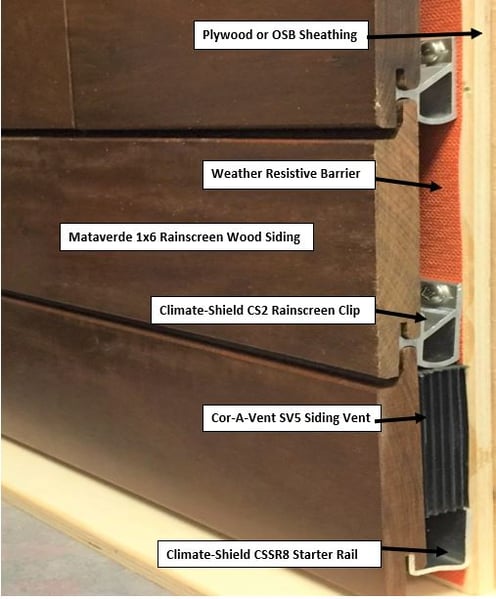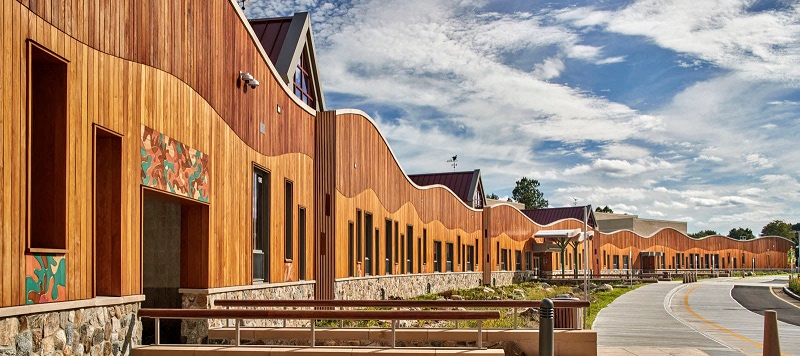
Understanding Wood Rainscreen Systems
What Is A Rainscreen? Optimizing Wood Siding for Performance, Sustainability, and Longevity
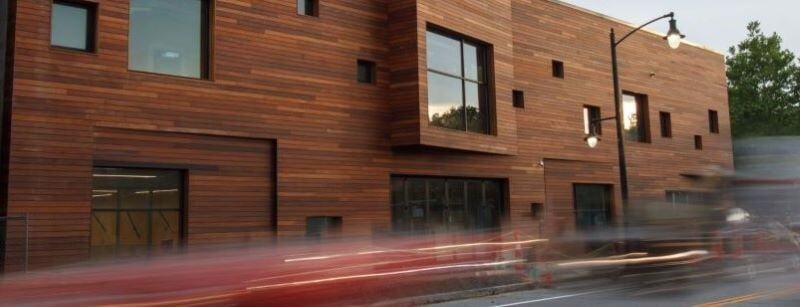
Ipe Wood Siding and Climate-Shield Rainscreen System on a music school exterior
On this page:
Wood rainscreen systems are pivotal to ensuring the longevity and structural integrity of today’s buildings, both residential and commercial. The combination of premium wood siding with an intentionally designed rainscreen system creates a compelling combination of aesthetic distinction and peak functionality.
Watch the video "What Is A Rainscreen Siding System", a quick demonstration of the top three types of rainscreen siding installation:
For architects, contractors, and homeowners it is essential to know the answer to “what is a rainscreen?”. This technology goes back centuries in Scandinavian architecture with structures that still stand today. Modern systems are just as robust. Ideal for architects and builders who prioritize high-end, high performing exteriors.
 Ipe wood rainscreen siding on the exterior walls with wood soffits
Ipe wood rainscreen siding on the exterior walls with wood soffits
Core Principles: How Rainscreen Systems Work
-
Keeping the Inside Dry: The inside exterior wall of the building is first covered with a water resistant barrier (WRB). This WRB lets water vapor out from the interior, but keeps bulk water from getting in.
-
The Outside Protection: The wood siding on the outside acts like a shield. It keeps rain, wind, and other weather away from the building.
-
Air Cavity: The space between the inside exterior wall and the outside siding is important. It lets water and humid air escape, which prevents wood from rotting or mold developing. It also helps keep the building warm or cool.
-
Healthy Buildings: By letting water and moist air out, a rainscreen system helps keep the inside and outside of the building healthy and lowers the chance of mold and mildew.
Climate-Shield Wood Rainscreen Siding System
Assembly Detail and Energy Savings |
Assembly Detail and Moisture Management |
Discover how a Wood Rainscreen Siding System can increase the sustainability and performance of your wood siding project. Get your copy of the Ultimate Guide to Building with Wood Rainscreen Siding here.
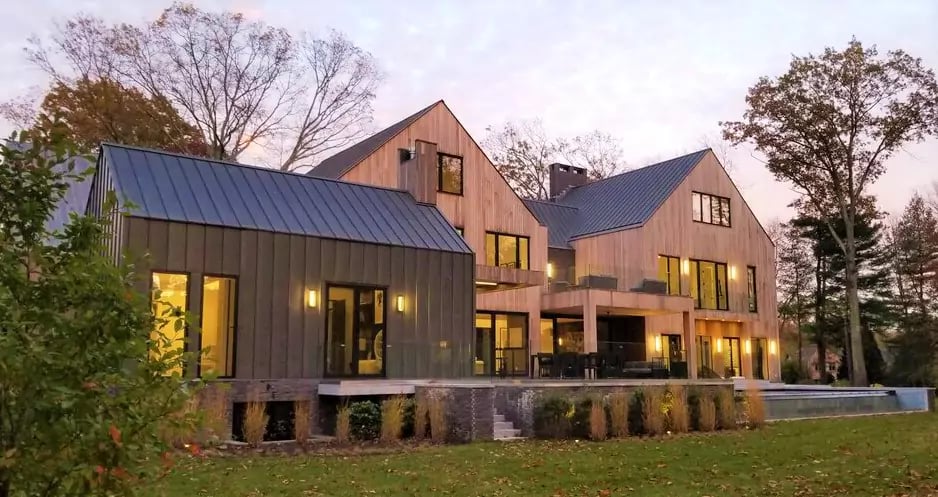
Garapa wood rainscreen vertical siding installation
Key Benefits of Rainscreen Wood Siding Systems:
-
Stops Water Build-Up: Traditional furring strip installation only allows water out of the top and bottom, and can trap water in corners. A better designed rainscreen lets air move freely. This makes sure water from inside and outside can escape from multiple points.
-
Stops Wind Pressure: Open rainscreen systems, like Climate-Shield, are pressurized systems that stop wind from pushing water into the wall. This is different from closed rainscreen systems.
-
Saves Energy: The air cavity helps keep the building warm or cool, which saves energy and can reduce energy costs.
-
Real Wood Beauty: With its warm, natural look, Wood siding makes buildings look welcoming and beautiful.
-
Increases Sustainability: By keeping the wood siding dry, a rainscreen system makes it last longer. This equals less need for repairs and delays replacement. This in turn cuts down on waste and helps the environment. All Mataverde wood rainscreen siding is sustainably sourced and recyclable.
Ready for a price on rainscreen siding? Request your project quote now.
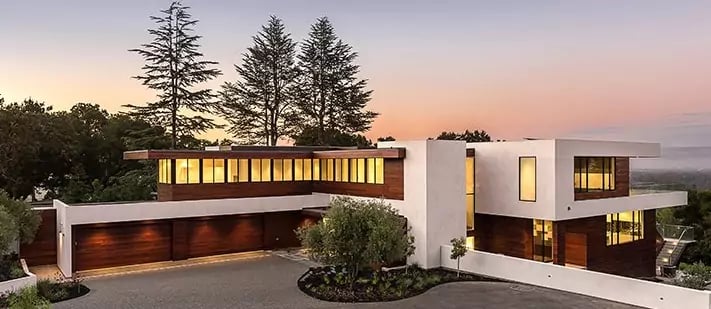 A custom luxury residence chose FSC Machiche Wood Rainscreen Siding for the exterior
A custom luxury residence chose FSC Machiche Wood Rainscreen Siding for the exterior
The air space in the wall cavity between the building envelope and the siding (referred to as the "rainscreen gap") allows moisture to escape and creates a passive insulation layer.
Unlike masonry curtain wall construction, where moisture is nearly trapped in the wall cavity, a proper wood rainscreen siding system should be an open-joint rainscreen or back ventilated wood siding system.
With a properly designed and installed wood rainscreen system:
- Interior moisture vapor from inside the structure passes to the outside without being trapped.
- Outside water that penetrates through the rainscreen joints can easily escape.
For high-end projects demanding both aesthetic appeal and superior performance, utilizing wood siding within a well-designed rainscreen creates durable, energy-efficient, and healthy structures that stand the test of time.

Climate-Shield vertical and diagonal siding installation with Mataverde ThermaWood Hem-Fir
Compare Climate-Shield to Furring Strip System
Traditional Furring Strip Systems |
Climate-Shield Rainscreen System |
|
Restricted Airflow: Creates isolated corners and chambers, limiting cross-ventilation and hindering moisture escape. |
Unrestricted Airflow: Climate-Shield Starter Rail and CS10 Rainscreen Clips allow bulk water and humid air to escape from the top, bottom, and between wood siding boards without obstacles. |
|
Thermal Bridging: Placed 16” on center, direct contact is approximately 16% or more of the building envelope. |
Reduced Thermal Bridging: Compact Rainscreen Clips significantly decrease points of contact, resulting in only and approximate 3-5% thermal bridging. |
|
Moisture Trapping and Decay: Corners trap and absorb moisture and humid air. This creates the potential for rot, decay, and mold growth behind the siding. |
Reduced Moisture Trapping and Decay: 100% metal Climate-Shield Starter Rail and Rainscreen Clips do not absorb moisture or create corners, significantly reducing the risk of mold and rotting. |
|
Increased Labor Costs: Furring strips require significant time and labor for installation on the exterior. |
Reduced Labor Costs: Rainscreen clips screw into exterior wall with two screws. It quickly and automatically creates the correct rainscreen air gap. |
|
Complex Vertical Siding Applications: Intricate grids are often required behind siding for vertical installations and custom architectural details. |
Design Flexibility: Climate-Shield Rainscreen Clips eliminate the need for complex grids behind vertical installations, wood soffits, and custom architectural details. Even diagonal installation is possible. |
|
N/A |
Simplified Installation: Patented clip system acts as its own spacer, ensuring consistent and uniform spacing. The starter rail aids in faster, automatic leveling. |
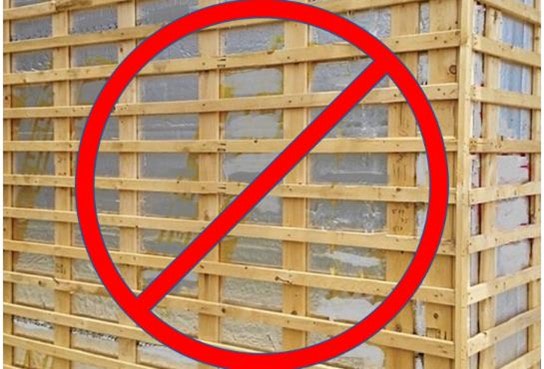
Avoid the traditional and labor intensive furring strip grids behind vertical rainscreen siding installations
RELATED: Check out Wood Rainscreen Project Case Studies Here
Frequently Asked Questions (FAQ's)
About the Climate-Shield Wood Rainscreen Siding System
Sustainable building practices have gained prominence. Rainscreen siding systems, like Climate-Shield, offer key advantages. This FAQ explains how they prevent moisture damage. We will also look at the different wood types you can use. You'll learn about the system's overall protection. Green building practices, cost, and the technology behind Climate-Shield are also covered. Our goal is to explain how these systems create durable, healthy, and eco-friendly buildings.
-
Why does a rainscreen siding system outperform regular siding?
Modern buildings are tightly sealed. This often traps moisture between the siding and the vapor barrier. This trapped moisture causes mold and mildew. Over time, this rots the building's structure.
Moisture also gets inside, which risks occupant health. A rainscreen system helps moisture evaporate naturally. This greatly reduces mold, mildew, and rot, and makes the inside of the building healthier.
-
Can Climate-Shield be used with softwood sidings?
Yes, the Climate-Shield Rainscreen Wood Siding System works well with many wood types. Builders can use both hardwood and softwood for exterior siding. Architects and builders have many choices. These include:
-
-
Softwood siding
-
-
Does Climate-Shield Rainscreen only protect against rain?
No, the Climate-Shield Rainscreen Wood Siding System does more than just stop rain. Its patented clip design creates a consistent insulation layer, also known as the wall cavity or rainscreen gap.
This gap reduces heat gain in hot weather and heat loss in cold weather. There are no exposed screws, so water cannot get and reduces thermal bridging. The system protects against all types of weather.
-
How do I keep bugs out from behind my siding?
To stop bugs, install a permeable insect barrier. A good choice is Cor-A-Vent SV-5. Place this at the bottom of the rainscreen siding to stop insects.
Use the Cor-A-Vent SV-5 at both the bottom and top of the siding to improve airflow. You can also put it above and below doors and windows for better ventilation.
-
Why do green building practices include rainscreen siding systems?
Rainscreen systems make buildings last longer. Therefore, they are a sustainable design best practice. They also meet health, safety, and welfare standards from the American Institute of Architects (AIA).
Climate-Shield has sustainable advantages over systems with furring strips. It removes a food source for mold and improves ventilation. This helps moisture dry quickly and reducing repairs or replacement.
-
How much design flexibility does the Climate-Shield system offer?
Architects and builders find the Climate-Shield Rainscreen System very flexible. They can use many wood siding materials and layouts. The system works with both modern and classic designs.
This flexibility lets them create custom looks and meet specific project criteria. Climate-Shield allow horizontal, vertical, even diagonal siding installation.
Climate-Shield eliminates the grid of furring strips behind wood soffits and architectural custom details. Architects and home designers can get the exact look and performance they want.
.jpg?width=450&height=600&name=ThermaWood%20FR%20Wood%20Ceiling%20Soffit%20on%20entryway%20atrium%20at%20Ragon%20institute%20photo%20courtesy%20of%20T.%20J.%20McCartney%2c%20Inc.%20%20(3).jpg) ThermaWood FR Wood Ceiling Soffit using Climate-Shield on entryway, courtesy of @T. J. McCartney, Inc.
ThermaWood FR Wood Ceiling Soffit using Climate-Shield on entryway, courtesy of @T. J. McCartney, Inc.
-
How does Climate-Shield Rainscreen surpass standard rainscreen wood siding?
Climate-Shield has several advantages. Removing the furring strips:
- Lowers material costs.
- Speeds up construction.
- Lowers labor and installation costs.
- Eliminates a mold food source and improves ventilation.
The Climate-Shield clip design also provides:
- Automatic even spacing for the rainscreen.
- Longer system life because it eliminates galvanized corrosion between the clip and screws.
- Stronger stability from the clip's two screws.
- Reduces thermal bridging to 3-5% of the surface area, compared to 16% for wood or metal furring strips, by reducing points of contact.
-
How much does Climate-Shield cost compared to other wood siding?
Climate-Shield costs less than other rainscreen methods with furring strips. Its initial cost is similar to regular siding.
When you look at the long-term costs, Climate-Shield saves you money. It increases siding life and sustainability, giving you an excellent return on investment (ROI).
RELATED: Compare Current Siding Costs
Ready for a price on rainscreen siding? Request your project quote now.
Questions? Need more information? Contact us!
RELATED:




